Operations Management: Leadership and Efficiency
VerifiedAdded on 2020/10/05
|13
|4290
|149
AI Summary
This assignment explores the concept of operations management, including its importance in achieving business goals and objectives. It delves into various leadership and management approaches that support employee motivation and growth, as well as techniques such as lean production, total quality management, and just-in-time to eliminate waste and improve product quality. The document provides a review of quantitative operations management approaches and challenges, along with case studies in medical management and teaching engineering for systems-based practice. It also discusses world-class manufacturing by Fiat, comparative analysis with Toyota's production system, and recent developments in OR/MS research in disaster operations management.
Contribute Materials
Your contribution can guide someone’s learning journey. Share your
documents today.

Management and
Operations
Operations
Secure Best Marks with AI Grader
Need help grading? Try our AI Grader for instant feedback on your assignments.

Table of Contents
INTRODUCTION...........................................................................................................................1
TASK 1............................................................................................................................................1
P1 Different roles & characteristics of a leader and manager................................................1
TASK 2............................................................................................................................................4
P2 Application of leader's role and manager's functions in different situational contexts.....4
P3 Application of different leadership theories & models of approach.................................5
TASK 3............................................................................................................................................7
P4 Key approaches to operations management and role that managers and leaders play......7
P5 Importance and value of operations management in accomplishing Business objectives 8
TASK 4............................................................................................................................................9
P6 Assessment of factors within business environment that influence operational management
and decision-making by managers and leaders......................................................................9
CONCLUSION..............................................................................................................................10
REFERENCES..............................................................................................................................11
INTRODUCTION...........................................................................................................................1
TASK 1............................................................................................................................................1
P1 Different roles & characteristics of a leader and manager................................................1
TASK 2............................................................................................................................................4
P2 Application of leader's role and manager's functions in different situational contexts.....4
P3 Application of different leadership theories & models of approach.................................5
TASK 3............................................................................................................................................7
P4 Key approaches to operations management and role that managers and leaders play......7
P5 Importance and value of operations management in accomplishing Business objectives 8
TASK 4............................................................................................................................................9
P6 Assessment of factors within business environment that influence operational management
and decision-making by managers and leaders......................................................................9
CONCLUSION..............................................................................................................................10
REFERENCES..............................................................................................................................11
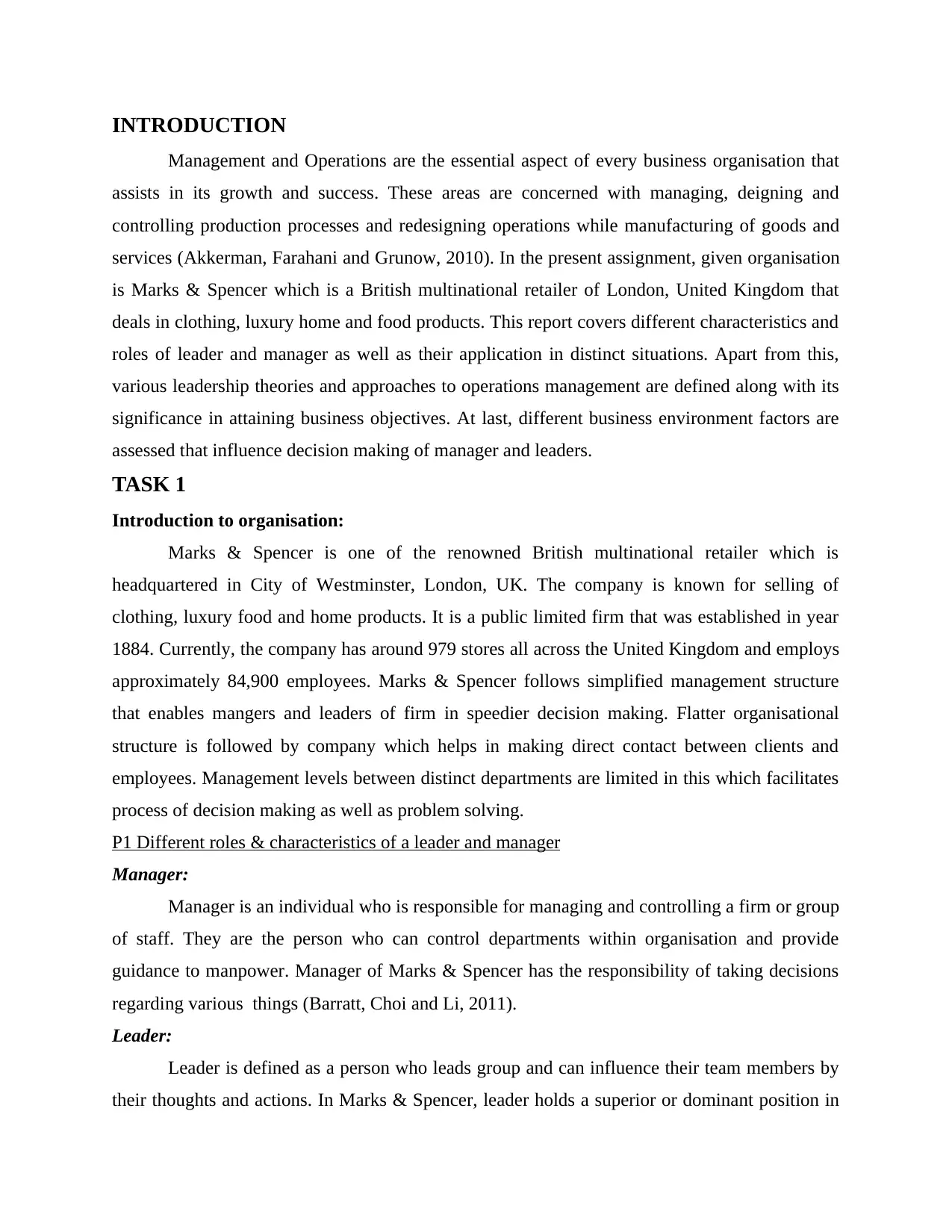
INTRODUCTION
Management and Operations are the essential aspect of every business organisation that
assists in its growth and success. These areas are concerned with managing, deigning and
controlling production processes and redesigning operations while manufacturing of goods and
services (Akkerman, Farahani and Grunow, 2010). In the present assignment, given organisation
is Marks & Spencer which is a British multinational retailer of London, United Kingdom that
deals in clothing, luxury home and food products. This report covers different characteristics and
roles of leader and manager as well as their application in distinct situations. Apart from this,
various leadership theories and approaches to operations management are defined along with its
significance in attaining business objectives. At last, different business environment factors are
assessed that influence decision making of manager and leaders.
TASK 1
Introduction to organisation:
Marks & Spencer is one of the renowned British multinational retailer which is
headquartered in City of Westminster, London, UK. The company is known for selling of
clothing, luxury food and home products. It is a public limited firm that was established in year
1884. Currently, the company has around 979 stores all across the United Kingdom and employs
approximately 84,900 employees. Marks & Spencer follows simplified management structure
that enables mangers and leaders of firm in speedier decision making. Flatter organisational
structure is followed by company which helps in making direct contact between clients and
employees. Management levels between distinct departments are limited in this which facilitates
process of decision making as well as problem solving.
P1 Different roles & characteristics of a leader and manager
Manager:
Manager is an individual who is responsible for managing and controlling a firm or group
of staff. They are the person who can control departments within organisation and provide
guidance to manpower. Manager of Marks & Spencer has the responsibility of taking decisions
regarding various things (Barratt, Choi and Li, 2011).
Leader:
Leader is defined as a person who leads group and can influence their team members by
their thoughts and actions. In Marks & Spencer, leader holds a superior or dominant position in
Management and Operations are the essential aspect of every business organisation that
assists in its growth and success. These areas are concerned with managing, deigning and
controlling production processes and redesigning operations while manufacturing of goods and
services (Akkerman, Farahani and Grunow, 2010). In the present assignment, given organisation
is Marks & Spencer which is a British multinational retailer of London, United Kingdom that
deals in clothing, luxury home and food products. This report covers different characteristics and
roles of leader and manager as well as their application in distinct situations. Apart from this,
various leadership theories and approaches to operations management are defined along with its
significance in attaining business objectives. At last, different business environment factors are
assessed that influence decision making of manager and leaders.
TASK 1
Introduction to organisation:
Marks & Spencer is one of the renowned British multinational retailer which is
headquartered in City of Westminster, London, UK. The company is known for selling of
clothing, luxury food and home products. It is a public limited firm that was established in year
1884. Currently, the company has around 979 stores all across the United Kingdom and employs
approximately 84,900 employees. Marks & Spencer follows simplified management structure
that enables mangers and leaders of firm in speedier decision making. Flatter organisational
structure is followed by company which helps in making direct contact between clients and
employees. Management levels between distinct departments are limited in this which facilitates
process of decision making as well as problem solving.
P1 Different roles & characteristics of a leader and manager
Manager:
Manager is an individual who is responsible for managing and controlling a firm or group
of staff. They are the person who can control departments within organisation and provide
guidance to manpower. Manager of Marks & Spencer has the responsibility of taking decisions
regarding various things (Barratt, Choi and Li, 2011).
Leader:
Leader is defined as a person who leads group and can influence their team members by
their thoughts and actions. In Marks & Spencer, leader holds a superior or dominant position in
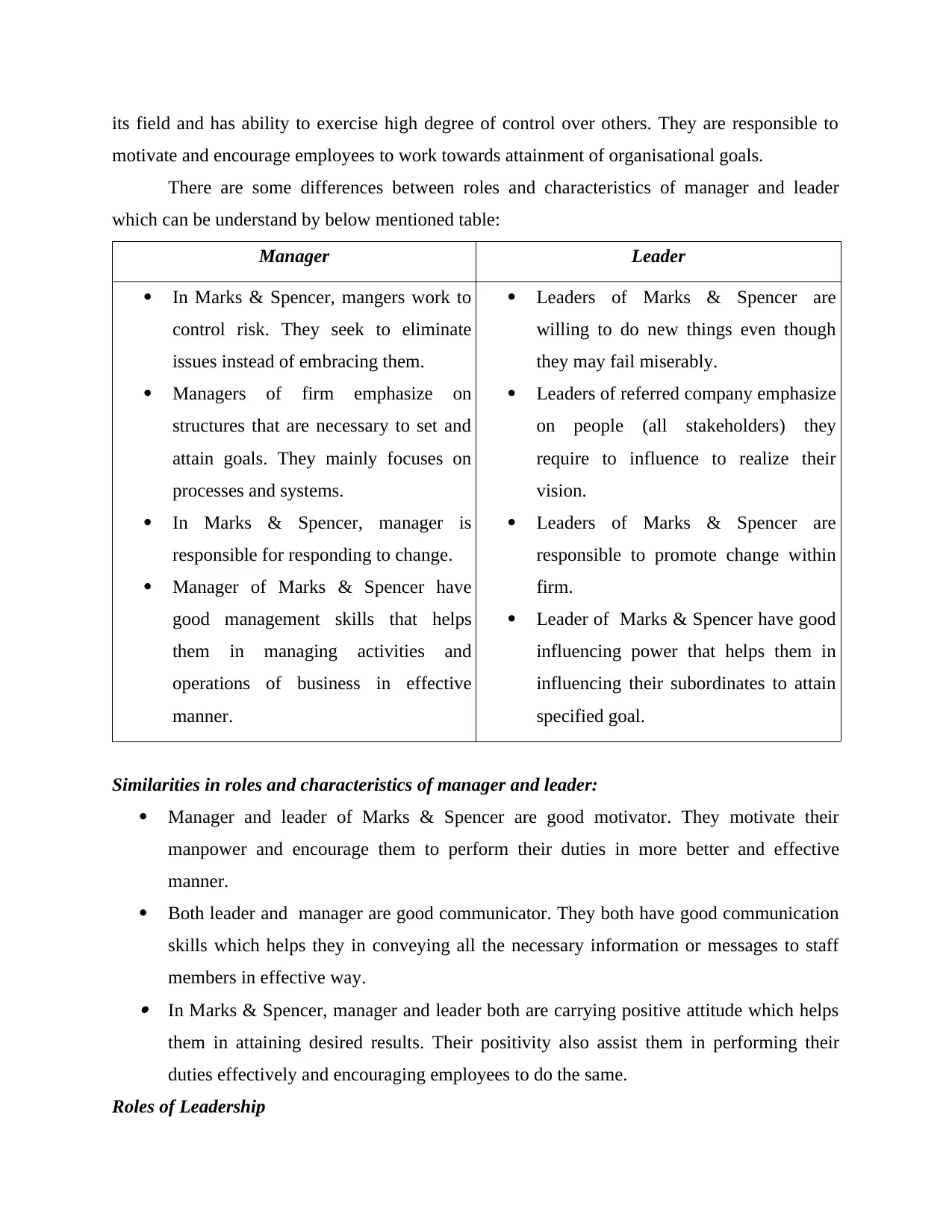
its field and has ability to exercise high degree of control over others. They are responsible to
motivate and encourage employees to work towards attainment of organisational goals.
There are some differences between roles and characteristics of manager and leader
which can be understand by below mentioned table:
Manager Leader
In Marks & Spencer, mangers work to
control risk. They seek to eliminate
issues instead of embracing them.
Managers of firm emphasize on
structures that are necessary to set and
attain goals. They mainly focuses on
processes and systems.
In Marks & Spencer, manager is
responsible for responding to change.
Manager of Marks & Spencer have
good management skills that helps
them in managing activities and
operations of business in effective
manner.
Leaders of Marks & Spencer are
willing to do new things even though
they may fail miserably.
Leaders of referred company emphasize
on people (all stakeholders) they
require to influence to realize their
vision.
Leaders of Marks & Spencer are
responsible to promote change within
firm.
Leader of Marks & Spencer have good
influencing power that helps them in
influencing their subordinates to attain
specified goal.
Similarities in roles and characteristics of manager and leader:
Manager and leader of Marks & Spencer are good motivator. They motivate their
manpower and encourage them to perform their duties in more better and effective
manner.
Both leader and manager are good communicator. They both have good communication
skills which helps they in conveying all the necessary information or messages to staff
members in effective way. In Marks & Spencer, manager and leader both are carrying positive attitude which helps
them in attaining desired results. Their positivity also assist them in performing their
duties effectively and encouraging employees to do the same.
Roles of Leadership
motivate and encourage employees to work towards attainment of organisational goals.
There are some differences between roles and characteristics of manager and leader
which can be understand by below mentioned table:
Manager Leader
In Marks & Spencer, mangers work to
control risk. They seek to eliminate
issues instead of embracing them.
Managers of firm emphasize on
structures that are necessary to set and
attain goals. They mainly focuses on
processes and systems.
In Marks & Spencer, manager is
responsible for responding to change.
Manager of Marks & Spencer have
good management skills that helps
them in managing activities and
operations of business in effective
manner.
Leaders of Marks & Spencer are
willing to do new things even though
they may fail miserably.
Leaders of referred company emphasize
on people (all stakeholders) they
require to influence to realize their
vision.
Leaders of Marks & Spencer are
responsible to promote change within
firm.
Leader of Marks & Spencer have good
influencing power that helps them in
influencing their subordinates to attain
specified goal.
Similarities in roles and characteristics of manager and leader:
Manager and leader of Marks & Spencer are good motivator. They motivate their
manpower and encourage them to perform their duties in more better and effective
manner.
Both leader and manager are good communicator. They both have good communication
skills which helps they in conveying all the necessary information or messages to staff
members in effective way. In Marks & Spencer, manager and leader both are carrying positive attitude which helps
them in attaining desired results. Their positivity also assist them in performing their
duties effectively and encouraging employees to do the same.
Roles of Leadership
Secure Best Marks with AI Grader
Need help grading? Try our AI Grader for instant feedback on your assignments.
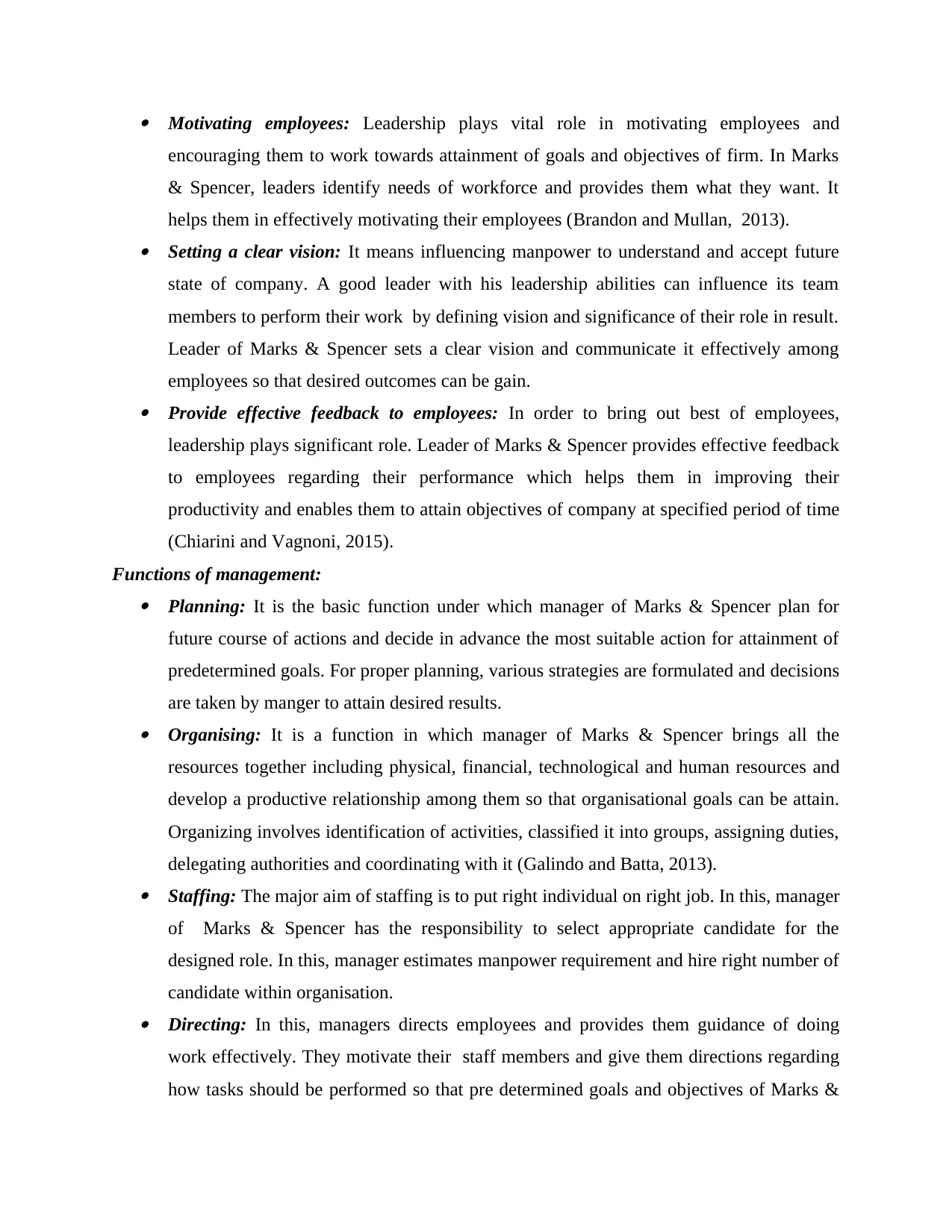
Motivating employees: Leadership plays vital role in motivating employees and
encouraging them to work towards attainment of goals and objectives of firm. In Marks
& Spencer, leaders identify needs of workforce and provides them what they want. It
helps them in effectively motivating their employees (Brandon and Mullan, 2013). Setting a clear vision: It means influencing manpower to understand and accept future
state of company. A good leader with his leadership abilities can influence its team
members to perform their work by defining vision and significance of their role in result.
Leader of Marks & Spencer sets a clear vision and communicate it effectively among
employees so that desired outcomes can be gain. Provide effective feedback to employees: In order to bring out best of employees,
leadership plays significant role. Leader of Marks & Spencer provides effective feedback
to employees regarding their performance which helps them in improving their
productivity and enables them to attain objectives of company at specified period of time
(Chiarini and Vagnoni, 2015).
Functions of management: Planning: It is the basic function under which manager of Marks & Spencer plan for
future course of actions and decide in advance the most suitable action for attainment of
predetermined goals. For proper planning, various strategies are formulated and decisions
are taken by manger to attain desired results. Organising: It is a function in which manager of Marks & Spencer brings all the
resources together including physical, financial, technological and human resources and
develop a productive relationship among them so that organisational goals can be attain.
Organizing involves identification of activities, classified it into groups, assigning duties,
delegating authorities and coordinating with it (Galindo and Batta, 2013). Staffing: The major aim of staffing is to put right individual on right job. In this, manager
of Marks & Spencer has the responsibility to select appropriate candidate for the
designed role. In this, manager estimates manpower requirement and hire right number of
candidate within organisation. Directing: In this, managers directs employees and provides them guidance of doing
work effectively. They motivate their staff members and give them directions regarding
how tasks should be performed so that pre determined goals and objectives of Marks &
encouraging them to work towards attainment of goals and objectives of firm. In Marks
& Spencer, leaders identify needs of workforce and provides them what they want. It
helps them in effectively motivating their employees (Brandon and Mullan, 2013). Setting a clear vision: It means influencing manpower to understand and accept future
state of company. A good leader with his leadership abilities can influence its team
members to perform their work by defining vision and significance of their role in result.
Leader of Marks & Spencer sets a clear vision and communicate it effectively among
employees so that desired outcomes can be gain. Provide effective feedback to employees: In order to bring out best of employees,
leadership plays significant role. Leader of Marks & Spencer provides effective feedback
to employees regarding their performance which helps them in improving their
productivity and enables them to attain objectives of company at specified period of time
(Chiarini and Vagnoni, 2015).
Functions of management: Planning: It is the basic function under which manager of Marks & Spencer plan for
future course of actions and decide in advance the most suitable action for attainment of
predetermined goals. For proper planning, various strategies are formulated and decisions
are taken by manger to attain desired results. Organising: It is a function in which manager of Marks & Spencer brings all the
resources together including physical, financial, technological and human resources and
develop a productive relationship among them so that organisational goals can be attain.
Organizing involves identification of activities, classified it into groups, assigning duties,
delegating authorities and coordinating with it (Galindo and Batta, 2013). Staffing: The major aim of staffing is to put right individual on right job. In this, manager
of Marks & Spencer has the responsibility to select appropriate candidate for the
designed role. In this, manager estimates manpower requirement and hire right number of
candidate within organisation. Directing: In this, managers directs employees and provides them guidance of doing
work effectively. They motivate their staff members and give them directions regarding
how tasks should be performed so that pre determined goals and objectives of Marks &
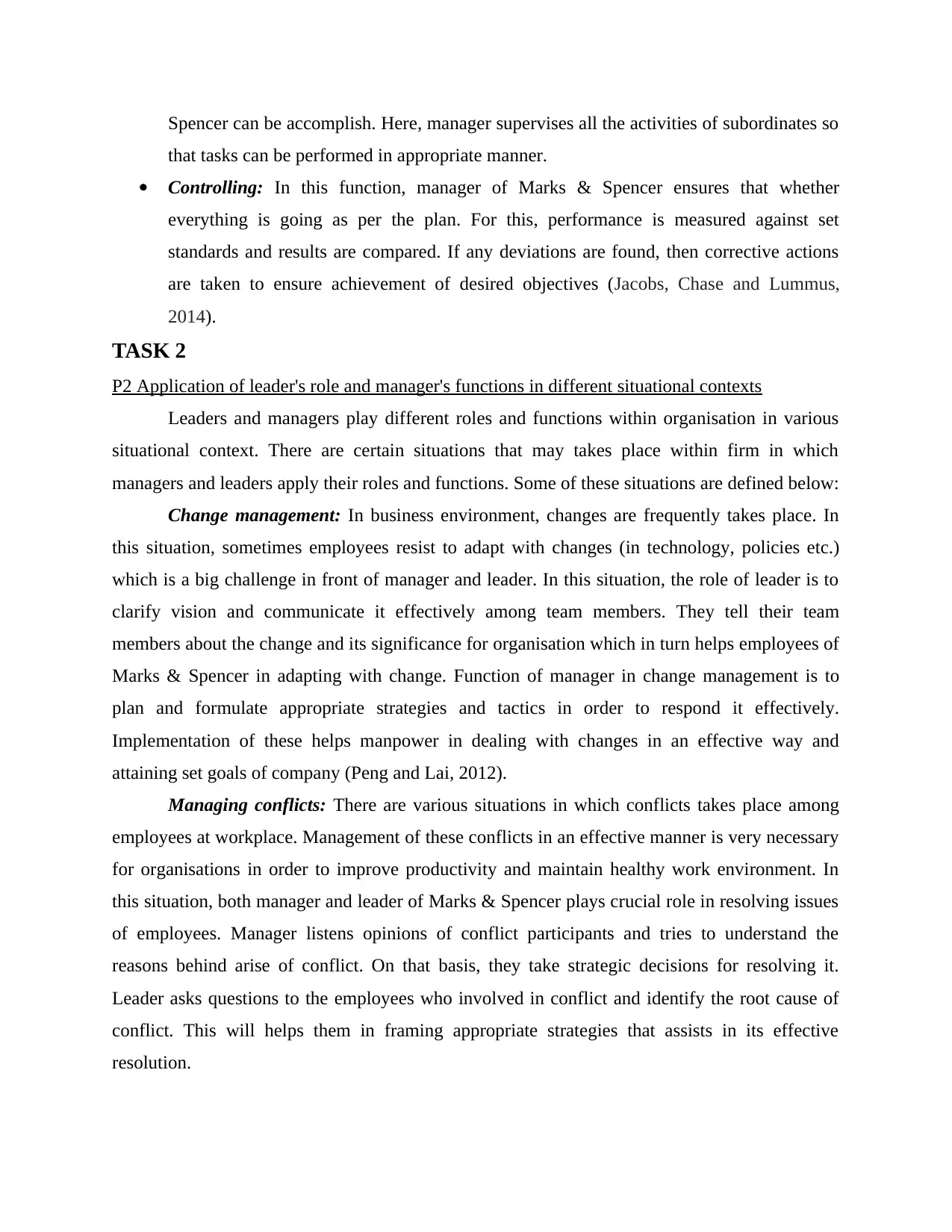
Spencer can be accomplish. Here, manager supervises all the activities of subordinates so
that tasks can be performed in appropriate manner.
Controlling: In this function, manager of Marks & Spencer ensures that whether
everything is going as per the plan. For this, performance is measured against set
standards and results are compared. If any deviations are found, then corrective actions
are taken to ensure achievement of desired objectives (Jacobs, Chase and Lummus,
2014).
TASK 2
P2 Application of leader's role and manager's functions in different situational contexts
Leaders and managers play different roles and functions within organisation in various
situational context. There are certain situations that may takes place within firm in which
managers and leaders apply their roles and functions. Some of these situations are defined below:
Change management: In business environment, changes are frequently takes place. In
this situation, sometimes employees resist to adapt with changes (in technology, policies etc.)
which is a big challenge in front of manager and leader. In this situation, the role of leader is to
clarify vision and communicate it effectively among team members. They tell their team
members about the change and its significance for organisation which in turn helps employees of
Marks & Spencer in adapting with change. Function of manager in change management is to
plan and formulate appropriate strategies and tactics in order to respond it effectively.
Implementation of these helps manpower in dealing with changes in an effective way and
attaining set goals of company (Peng and Lai, 2012).
Managing conflicts: There are various situations in which conflicts takes place among
employees at workplace. Management of these conflicts in an effective manner is very necessary
for organisations in order to improve productivity and maintain healthy work environment. In
this situation, both manager and leader of Marks & Spencer plays crucial role in resolving issues
of employees. Manager listens opinions of conflict participants and tries to understand the
reasons behind arise of conflict. On that basis, they take strategic decisions for resolving it.
Leader asks questions to the employees who involved in conflict and identify the root cause of
conflict. This will helps them in framing appropriate strategies that assists in its effective
resolution.
that tasks can be performed in appropriate manner.
Controlling: In this function, manager of Marks & Spencer ensures that whether
everything is going as per the plan. For this, performance is measured against set
standards and results are compared. If any deviations are found, then corrective actions
are taken to ensure achievement of desired objectives (Jacobs, Chase and Lummus,
2014).
TASK 2
P2 Application of leader's role and manager's functions in different situational contexts
Leaders and managers play different roles and functions within organisation in various
situational context. There are certain situations that may takes place within firm in which
managers and leaders apply their roles and functions. Some of these situations are defined below:
Change management: In business environment, changes are frequently takes place. In
this situation, sometimes employees resist to adapt with changes (in technology, policies etc.)
which is a big challenge in front of manager and leader. In this situation, the role of leader is to
clarify vision and communicate it effectively among team members. They tell their team
members about the change and its significance for organisation which in turn helps employees of
Marks & Spencer in adapting with change. Function of manager in change management is to
plan and formulate appropriate strategies and tactics in order to respond it effectively.
Implementation of these helps manpower in dealing with changes in an effective way and
attaining set goals of company (Peng and Lai, 2012).
Managing conflicts: There are various situations in which conflicts takes place among
employees at workplace. Management of these conflicts in an effective manner is very necessary
for organisations in order to improve productivity and maintain healthy work environment. In
this situation, both manager and leader of Marks & Spencer plays crucial role in resolving issues
of employees. Manager listens opinions of conflict participants and tries to understand the
reasons behind arise of conflict. On that basis, they take strategic decisions for resolving it.
Leader asks questions to the employees who involved in conflict and identify the root cause of
conflict. This will helps them in framing appropriate strategies that assists in its effective
resolution.
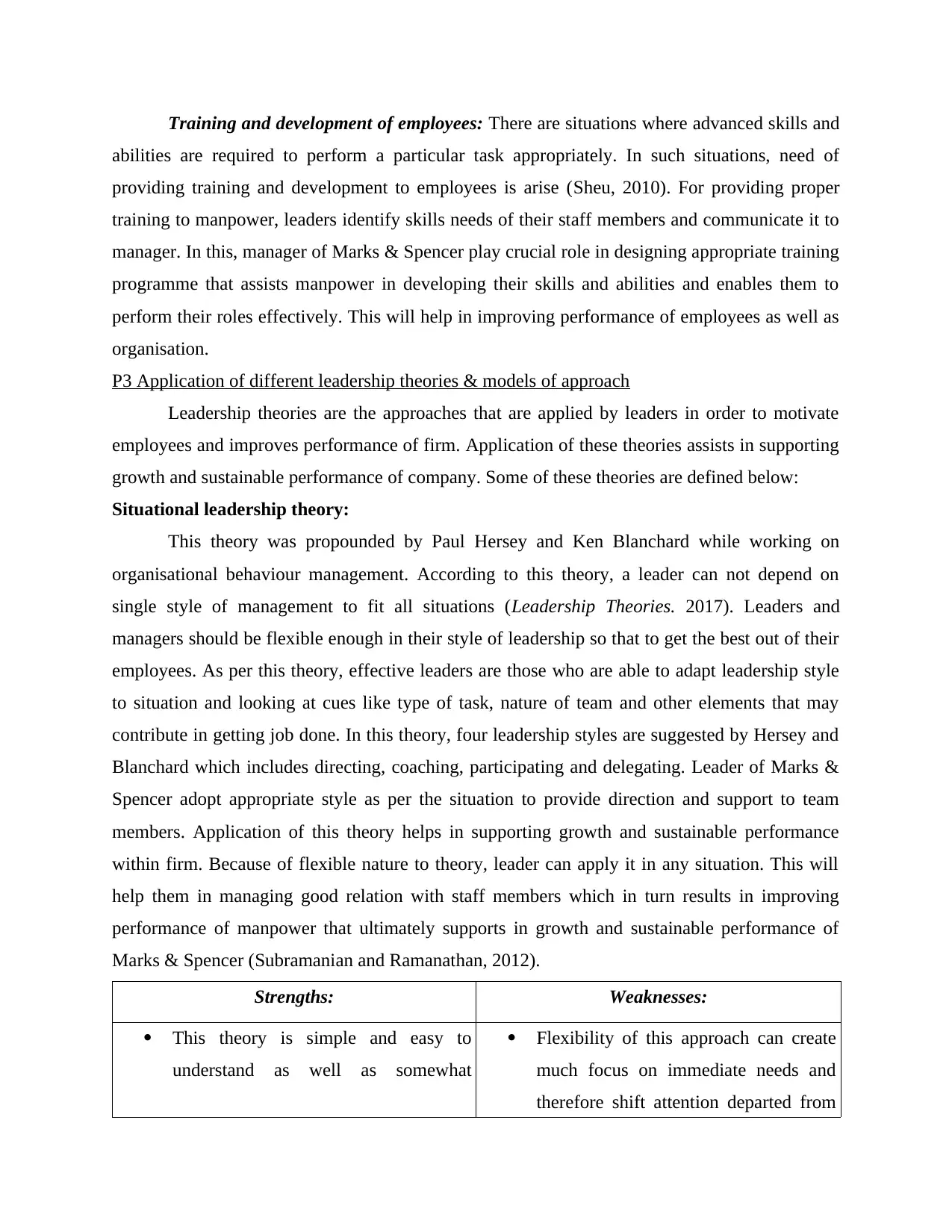
Training and development of employees: There are situations where advanced skills and
abilities are required to perform a particular task appropriately. In such situations, need of
providing training and development to employees is arise (Sheu, 2010). For providing proper
training to manpower, leaders identify skills needs of their staff members and communicate it to
manager. In this, manager of Marks & Spencer play crucial role in designing appropriate training
programme that assists manpower in developing their skills and abilities and enables them to
perform their roles effectively. This will help in improving performance of employees as well as
organisation.
P3 Application of different leadership theories & models of approach
Leadership theories are the approaches that are applied by leaders in order to motivate
employees and improves performance of firm. Application of these theories assists in supporting
growth and sustainable performance of company. Some of these theories are defined below:
Situational leadership theory:
This theory was propounded by Paul Hersey and Ken Blanchard while working on
organisational behaviour management. According to this theory, a leader can not depend on
single style of management to fit all situations (Leadership Theories. 2017). Leaders and
managers should be flexible enough in their style of leadership so that to get the best out of their
employees. As per this theory, effective leaders are those who are able to adapt leadership style
to situation and looking at cues like type of task, nature of team and other elements that may
contribute in getting job done. In this theory, four leadership styles are suggested by Hersey and
Blanchard which includes directing, coaching, participating and delegating. Leader of Marks &
Spencer adopt appropriate style as per the situation to provide direction and support to team
members. Application of this theory helps in supporting growth and sustainable performance
within firm. Because of flexible nature to theory, leader can apply it in any situation. This will
help them in managing good relation with staff members which in turn results in improving
performance of manpower that ultimately supports in growth and sustainable performance of
Marks & Spencer (Subramanian and Ramanathan, 2012).
Strengths: Weaknesses:
This theory is simple and easy to
understand as well as somewhat
Flexibility of this approach can create
much focus on immediate needs and
therefore shift attention departed from
abilities are required to perform a particular task appropriately. In such situations, need of
providing training and development to employees is arise (Sheu, 2010). For providing proper
training to manpower, leaders identify skills needs of their staff members and communicate it to
manager. In this, manager of Marks & Spencer play crucial role in designing appropriate training
programme that assists manpower in developing their skills and abilities and enables them to
perform their roles effectively. This will help in improving performance of employees as well as
organisation.
P3 Application of different leadership theories & models of approach
Leadership theories are the approaches that are applied by leaders in order to motivate
employees and improves performance of firm. Application of these theories assists in supporting
growth and sustainable performance of company. Some of these theories are defined below:
Situational leadership theory:
This theory was propounded by Paul Hersey and Ken Blanchard while working on
organisational behaviour management. According to this theory, a leader can not depend on
single style of management to fit all situations (Leadership Theories. 2017). Leaders and
managers should be flexible enough in their style of leadership so that to get the best out of their
employees. As per this theory, effective leaders are those who are able to adapt leadership style
to situation and looking at cues like type of task, nature of team and other elements that may
contribute in getting job done. In this theory, four leadership styles are suggested by Hersey and
Blanchard which includes directing, coaching, participating and delegating. Leader of Marks &
Spencer adopt appropriate style as per the situation to provide direction and support to team
members. Application of this theory helps in supporting growth and sustainable performance
within firm. Because of flexible nature to theory, leader can apply it in any situation. This will
help them in managing good relation with staff members which in turn results in improving
performance of manpower that ultimately supports in growth and sustainable performance of
Marks & Spencer (Subramanian and Ramanathan, 2012).
Strengths: Weaknesses:
This theory is simple and easy to
understand as well as somewhat
Flexibility of this approach can create
much focus on immediate needs and
therefore shift attention departed from
Paraphrase This Document
Need a fresh take? Get an instant paraphrase of this document with our AI Paraphraser
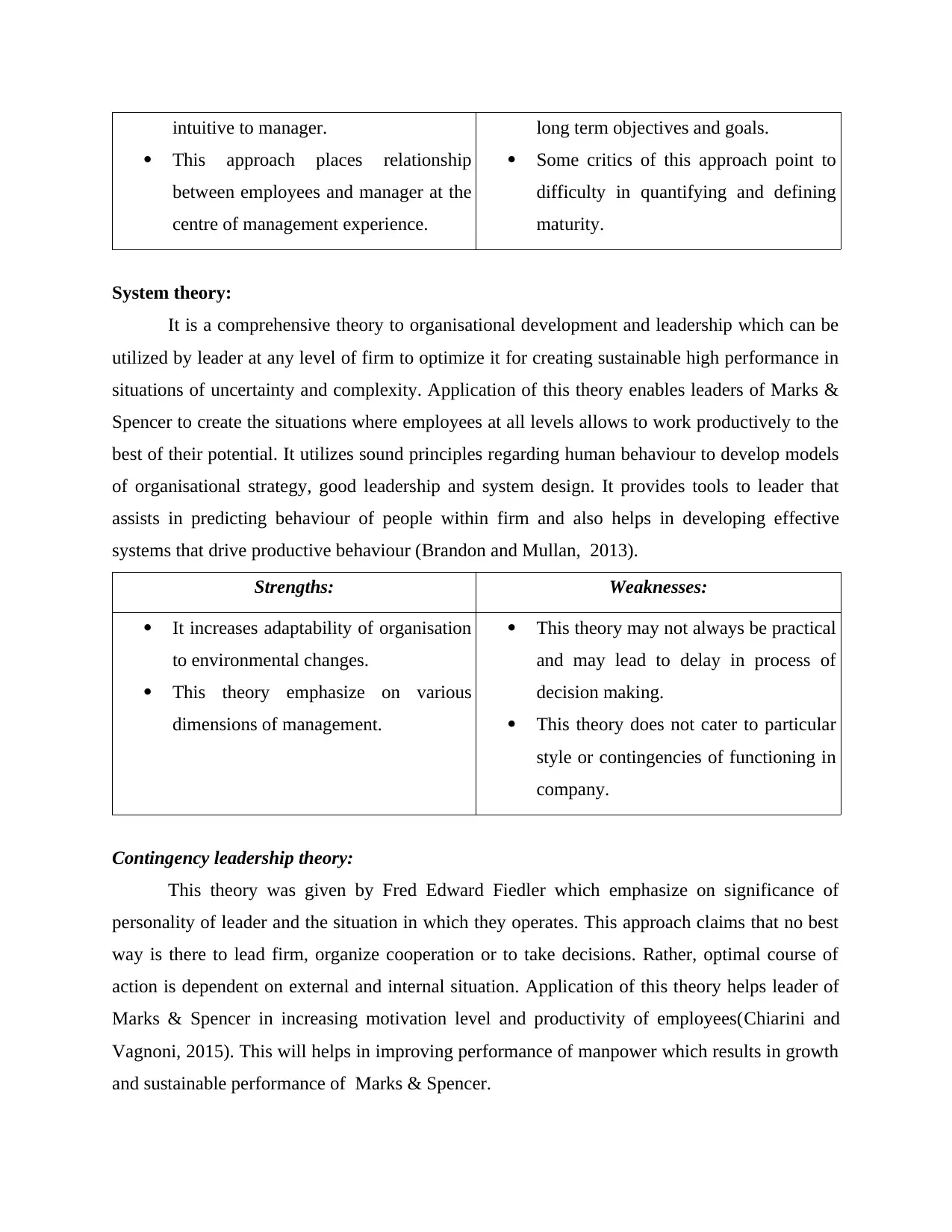
intuitive to manager.
This approach places relationship
between employees and manager at the
centre of management experience.
long term objectives and goals.
Some critics of this approach point to
difficulty in quantifying and defining
maturity.
System theory:
It is a comprehensive theory to organisational development and leadership which can be
utilized by leader at any level of firm to optimize it for creating sustainable high performance in
situations of uncertainty and complexity. Application of this theory enables leaders of Marks &
Spencer to create the situations where employees at all levels allows to work productively to the
best of their potential. It utilizes sound principles regarding human behaviour to develop models
of organisational strategy, good leadership and system design. It provides tools to leader that
assists in predicting behaviour of people within firm and also helps in developing effective
systems that drive productive behaviour (Brandon and Mullan, 2013).
Strengths: Weaknesses:
It increases adaptability of organisation
to environmental changes.
This theory emphasize on various
dimensions of management.
This theory may not always be practical
and may lead to delay in process of
decision making.
This theory does not cater to particular
style or contingencies of functioning in
company.
Contingency leadership theory:
This theory was given by Fred Edward Fiedler which emphasize on significance of
personality of leader and the situation in which they operates. This approach claims that no best
way is there to lead firm, organize cooperation or to take decisions. Rather, optimal course of
action is dependent on external and internal situation. Application of this theory helps leader of
Marks & Spencer in increasing motivation level and productivity of employees(Chiarini and
Vagnoni, 2015). This will helps in improving performance of manpower which results in growth
and sustainable performance of Marks & Spencer.
This approach places relationship
between employees and manager at the
centre of management experience.
long term objectives and goals.
Some critics of this approach point to
difficulty in quantifying and defining
maturity.
System theory:
It is a comprehensive theory to organisational development and leadership which can be
utilized by leader at any level of firm to optimize it for creating sustainable high performance in
situations of uncertainty and complexity. Application of this theory enables leaders of Marks &
Spencer to create the situations where employees at all levels allows to work productively to the
best of their potential. It utilizes sound principles regarding human behaviour to develop models
of organisational strategy, good leadership and system design. It provides tools to leader that
assists in predicting behaviour of people within firm and also helps in developing effective
systems that drive productive behaviour (Brandon and Mullan, 2013).
Strengths: Weaknesses:
It increases adaptability of organisation
to environmental changes.
This theory emphasize on various
dimensions of management.
This theory may not always be practical
and may lead to delay in process of
decision making.
This theory does not cater to particular
style or contingencies of functioning in
company.
Contingency leadership theory:
This theory was given by Fred Edward Fiedler which emphasize on significance of
personality of leader and the situation in which they operates. This approach claims that no best
way is there to lead firm, organize cooperation or to take decisions. Rather, optimal course of
action is dependent on external and internal situation. Application of this theory helps leader of
Marks & Spencer in increasing motivation level and productivity of employees(Chiarini and
Vagnoni, 2015). This will helps in improving performance of manpower which results in growth
and sustainable performance of Marks & Spencer.
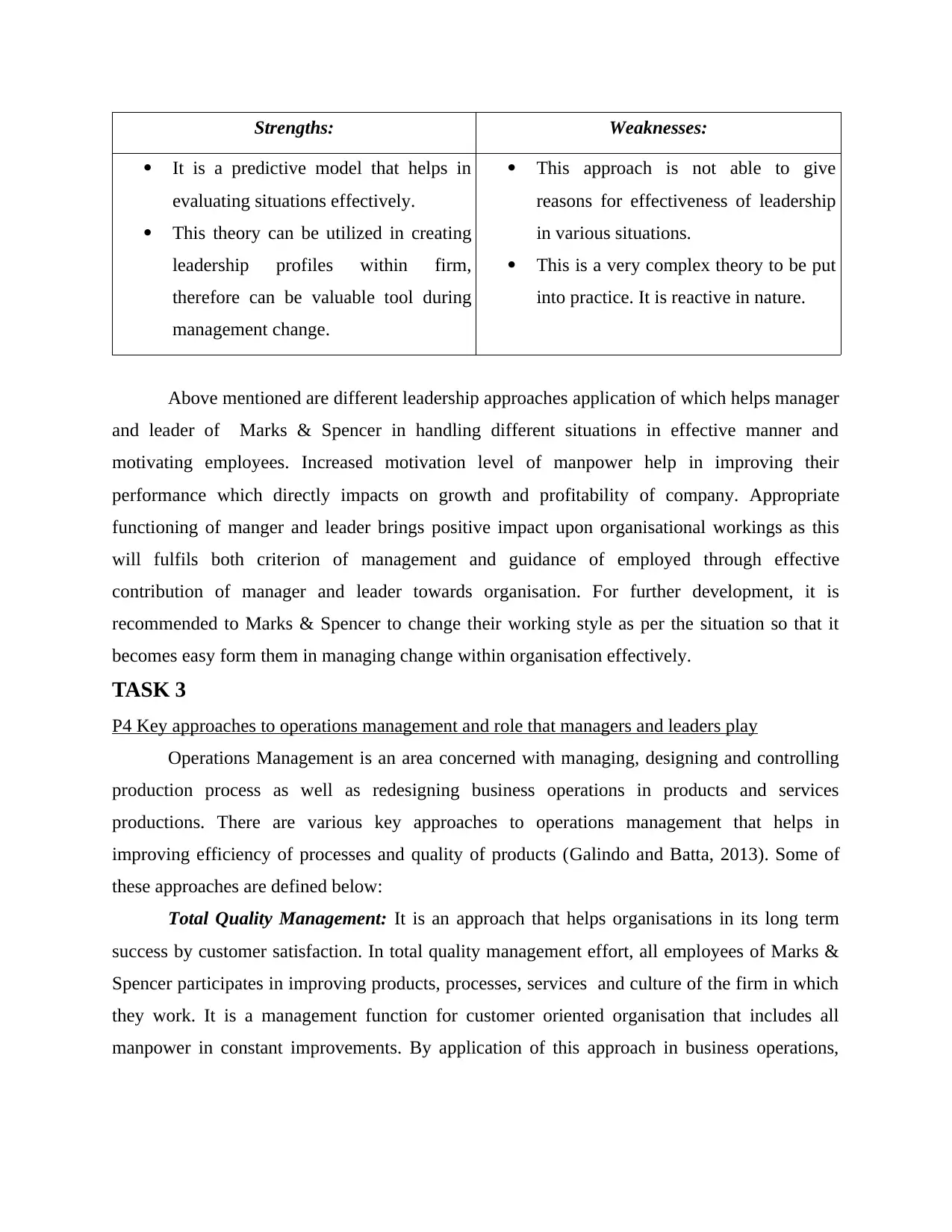
Strengths: Weaknesses:
It is a predictive model that helps in
evaluating situations effectively.
This theory can be utilized in creating
leadership profiles within firm,
therefore can be valuable tool during
management change.
This approach is not able to give
reasons for effectiveness of leadership
in various situations.
This is a very complex theory to be put
into practice. It is reactive in nature.
Above mentioned are different leadership approaches application of which helps manager
and leader of Marks & Spencer in handling different situations in effective manner and
motivating employees. Increased motivation level of manpower help in improving their
performance which directly impacts on growth and profitability of company. Appropriate
functioning of manger and leader brings positive impact upon organisational workings as this
will fulfils both criterion of management and guidance of employed through effective
contribution of manager and leader towards organisation. For further development, it is
recommended to Marks & Spencer to change their working style as per the situation so that it
becomes easy form them in managing change within organisation effectively.
TASK 3
P4 Key approaches to operations management and role that managers and leaders play
Operations Management is an area concerned with managing, designing and controlling
production process as well as redesigning business operations in products and services
productions. There are various key approaches to operations management that helps in
improving efficiency of processes and quality of products (Galindo and Batta, 2013). Some of
these approaches are defined below:
Total Quality Management: It is an approach that helps organisations in its long term
success by customer satisfaction. In total quality management effort, all employees of Marks &
Spencer participates in improving products, processes, services and culture of the firm in which
they work. It is a management function for customer oriented organisation that includes all
manpower in constant improvements. By application of this approach in business operations,
It is a predictive model that helps in
evaluating situations effectively.
This theory can be utilized in creating
leadership profiles within firm,
therefore can be valuable tool during
management change.
This approach is not able to give
reasons for effectiveness of leadership
in various situations.
This is a very complex theory to be put
into practice. It is reactive in nature.
Above mentioned are different leadership approaches application of which helps manager
and leader of Marks & Spencer in handling different situations in effective manner and
motivating employees. Increased motivation level of manpower help in improving their
performance which directly impacts on growth and profitability of company. Appropriate
functioning of manger and leader brings positive impact upon organisational workings as this
will fulfils both criterion of management and guidance of employed through effective
contribution of manager and leader towards organisation. For further development, it is
recommended to Marks & Spencer to change their working style as per the situation so that it
becomes easy form them in managing change within organisation effectively.
TASK 3
P4 Key approaches to operations management and role that managers and leaders play
Operations Management is an area concerned with managing, designing and controlling
production process as well as redesigning business operations in products and services
productions. There are various key approaches to operations management that helps in
improving efficiency of processes and quality of products (Galindo and Batta, 2013). Some of
these approaches are defined below:
Total Quality Management: It is an approach that helps organisations in its long term
success by customer satisfaction. In total quality management effort, all employees of Marks &
Spencer participates in improving products, processes, services and culture of the firm in which
they work. It is a management function for customer oriented organisation that includes all
manpower in constant improvements. By application of this approach in business operations,
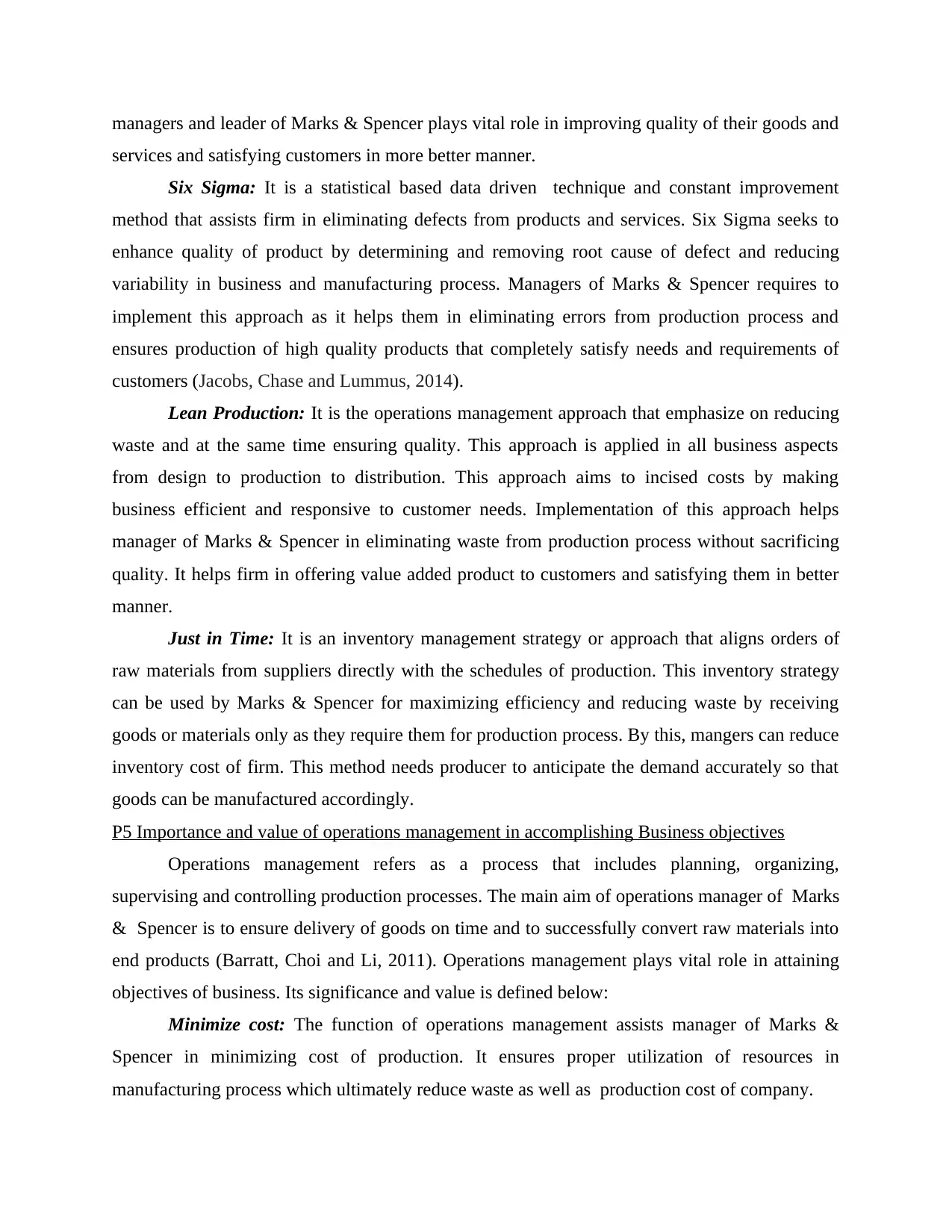
managers and leader of Marks & Spencer plays vital role in improving quality of their goods and
services and satisfying customers in more better manner.
Six Sigma: It is a statistical based data driven technique and constant improvement
method that assists firm in eliminating defects from products and services. Six Sigma seeks to
enhance quality of product by determining and removing root cause of defect and reducing
variability in business and manufacturing process. Managers of Marks & Spencer requires to
implement this approach as it helps them in eliminating errors from production process and
ensures production of high quality products that completely satisfy needs and requirements of
customers (Jacobs, Chase and Lummus, 2014).
Lean Production: It is the operations management approach that emphasize on reducing
waste and at the same time ensuring quality. This approach is applied in all business aspects
from design to production to distribution. This approach aims to incised costs by making
business efficient and responsive to customer needs. Implementation of this approach helps
manager of Marks & Spencer in eliminating waste from production process without sacrificing
quality. It helps firm in offering value added product to customers and satisfying them in better
manner.
Just in Time: It is an inventory management strategy or approach that aligns orders of
raw materials from suppliers directly with the schedules of production. This inventory strategy
can be used by Marks & Spencer for maximizing efficiency and reducing waste by receiving
goods or materials only as they require them for production process. By this, mangers can reduce
inventory cost of firm. This method needs producer to anticipate the demand accurately so that
goods can be manufactured accordingly.
P5 Importance and value of operations management in accomplishing Business objectives
Operations management refers as a process that includes planning, organizing,
supervising and controlling production processes. The main aim of operations manager of Marks
& Spencer is to ensure delivery of goods on time and to successfully convert raw materials into
end products (Barratt, Choi and Li, 2011). Operations management plays vital role in attaining
objectives of business. Its significance and value is defined below:
Minimize cost: The function of operations management assists manager of Marks &
Spencer in minimizing cost of production. It ensures proper utilization of resources in
manufacturing process which ultimately reduce waste as well as production cost of company.
services and satisfying customers in more better manner.
Six Sigma: It is a statistical based data driven technique and constant improvement
method that assists firm in eliminating defects from products and services. Six Sigma seeks to
enhance quality of product by determining and removing root cause of defect and reducing
variability in business and manufacturing process. Managers of Marks & Spencer requires to
implement this approach as it helps them in eliminating errors from production process and
ensures production of high quality products that completely satisfy needs and requirements of
customers (Jacobs, Chase and Lummus, 2014).
Lean Production: It is the operations management approach that emphasize on reducing
waste and at the same time ensuring quality. This approach is applied in all business aspects
from design to production to distribution. This approach aims to incised costs by making
business efficient and responsive to customer needs. Implementation of this approach helps
manager of Marks & Spencer in eliminating waste from production process without sacrificing
quality. It helps firm in offering value added product to customers and satisfying them in better
manner.
Just in Time: It is an inventory management strategy or approach that aligns orders of
raw materials from suppliers directly with the schedules of production. This inventory strategy
can be used by Marks & Spencer for maximizing efficiency and reducing waste by receiving
goods or materials only as they require them for production process. By this, mangers can reduce
inventory cost of firm. This method needs producer to anticipate the demand accurately so that
goods can be manufactured accordingly.
P5 Importance and value of operations management in accomplishing Business objectives
Operations management refers as a process that includes planning, organizing,
supervising and controlling production processes. The main aim of operations manager of Marks
& Spencer is to ensure delivery of goods on time and to successfully convert raw materials into
end products (Barratt, Choi and Li, 2011). Operations management plays vital role in attaining
objectives of business. Its significance and value is defined below:
Minimize cost: The function of operations management assists manager of Marks &
Spencer in minimizing cost of production. It ensures proper utilization of resources in
manufacturing process which ultimately reduce waste as well as production cost of company.
Secure Best Marks with AI Grader
Need help grading? Try our AI Grader for instant feedback on your assignments.
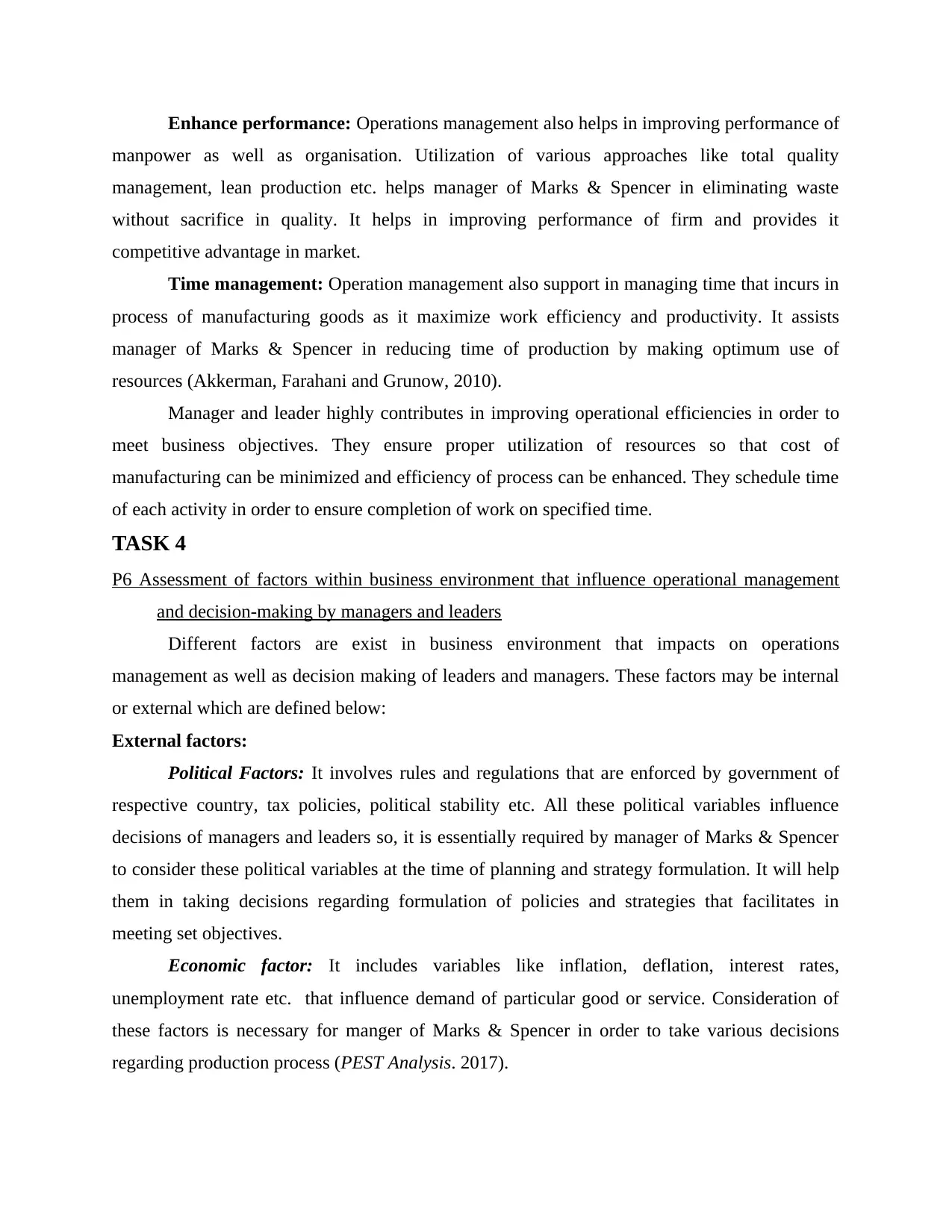
Enhance performance: Operations management also helps in improving performance of
manpower as well as organisation. Utilization of various approaches like total quality
management, lean production etc. helps manager of Marks & Spencer in eliminating waste
without sacrifice in quality. It helps in improving performance of firm and provides it
competitive advantage in market.
Time management: Operation management also support in managing time that incurs in
process of manufacturing goods as it maximize work efficiency and productivity. It assists
manager of Marks & Spencer in reducing time of production by making optimum use of
resources (Akkerman, Farahani and Grunow, 2010).
Manager and leader highly contributes in improving operational efficiencies in order to
meet business objectives. They ensure proper utilization of resources so that cost of
manufacturing can be minimized and efficiency of process can be enhanced. They schedule time
of each activity in order to ensure completion of work on specified time.
TASK 4
P6 Assessment of factors within business environment that influence operational management
and decision-making by managers and leaders
Different factors are exist in business environment that impacts on operations
management as well as decision making of leaders and managers. These factors may be internal
or external which are defined below:
External factors:
Political Factors: It involves rules and regulations that are enforced by government of
respective country, tax policies, political stability etc. All these political variables influence
decisions of managers and leaders so, it is essentially required by manager of Marks & Spencer
to consider these political variables at the time of planning and strategy formulation. It will help
them in taking decisions regarding formulation of policies and strategies that facilitates in
meeting set objectives.
Economic factor: It includes variables like inflation, deflation, interest rates,
unemployment rate etc. that influence demand of particular good or service. Consideration of
these factors is necessary for manger of Marks & Spencer in order to take various decisions
regarding production process (PEST Analysis. 2017).
manpower as well as organisation. Utilization of various approaches like total quality
management, lean production etc. helps manager of Marks & Spencer in eliminating waste
without sacrifice in quality. It helps in improving performance of firm and provides it
competitive advantage in market.
Time management: Operation management also support in managing time that incurs in
process of manufacturing goods as it maximize work efficiency and productivity. It assists
manager of Marks & Spencer in reducing time of production by making optimum use of
resources (Akkerman, Farahani and Grunow, 2010).
Manager and leader highly contributes in improving operational efficiencies in order to
meet business objectives. They ensure proper utilization of resources so that cost of
manufacturing can be minimized and efficiency of process can be enhanced. They schedule time
of each activity in order to ensure completion of work on specified time.
TASK 4
P6 Assessment of factors within business environment that influence operational management
and decision-making by managers and leaders
Different factors are exist in business environment that impacts on operations
management as well as decision making of leaders and managers. These factors may be internal
or external which are defined below:
External factors:
Political Factors: It involves rules and regulations that are enforced by government of
respective country, tax policies, political stability etc. All these political variables influence
decisions of managers and leaders so, it is essentially required by manager of Marks & Spencer
to consider these political variables at the time of planning and strategy formulation. It will help
them in taking decisions regarding formulation of policies and strategies that facilitates in
meeting set objectives.
Economic factor: It includes variables like inflation, deflation, interest rates,
unemployment rate etc. that influence demand of particular good or service. Consideration of
these factors is necessary for manger of Marks & Spencer in order to take various decisions
regarding production process (PEST Analysis. 2017).
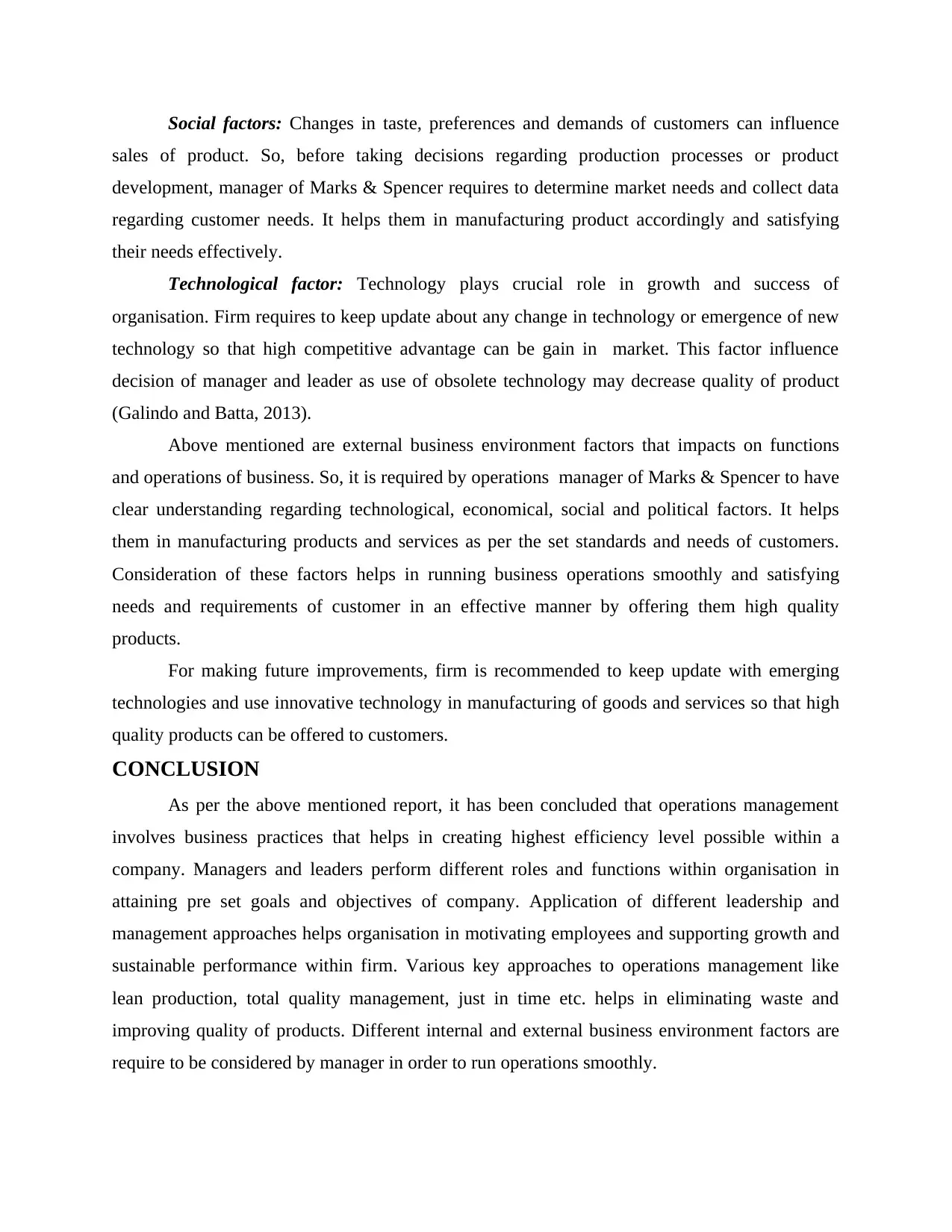
Social factors: Changes in taste, preferences and demands of customers can influence
sales of product. So, before taking decisions regarding production processes or product
development, manager of Marks & Spencer requires to determine market needs and collect data
regarding customer needs. It helps them in manufacturing product accordingly and satisfying
their needs effectively.
Technological factor: Technology plays crucial role in growth and success of
organisation. Firm requires to keep update about any change in technology or emergence of new
technology so that high competitive advantage can be gain in market. This factor influence
decision of manager and leader as use of obsolete technology may decrease quality of product
(Galindo and Batta, 2013).
Above mentioned are external business environment factors that impacts on functions
and operations of business. So, it is required by operations manager of Marks & Spencer to have
clear understanding regarding technological, economical, social and political factors. It helps
them in manufacturing products and services as per the set standards and needs of customers.
Consideration of these factors helps in running business operations smoothly and satisfying
needs and requirements of customer in an effective manner by offering them high quality
products.
For making future improvements, firm is recommended to keep update with emerging
technologies and use innovative technology in manufacturing of goods and services so that high
quality products can be offered to customers.
CONCLUSION
As per the above mentioned report, it has been concluded that operations management
involves business practices that helps in creating highest efficiency level possible within a
company. Managers and leaders perform different roles and functions within organisation in
attaining pre set goals and objectives of company. Application of different leadership and
management approaches helps organisation in motivating employees and supporting growth and
sustainable performance within firm. Various key approaches to operations management like
lean production, total quality management, just in time etc. helps in eliminating waste and
improving quality of products. Different internal and external business environment factors are
require to be considered by manager in order to run operations smoothly.
sales of product. So, before taking decisions regarding production processes or product
development, manager of Marks & Spencer requires to determine market needs and collect data
regarding customer needs. It helps them in manufacturing product accordingly and satisfying
their needs effectively.
Technological factor: Technology plays crucial role in growth and success of
organisation. Firm requires to keep update about any change in technology or emergence of new
technology so that high competitive advantage can be gain in market. This factor influence
decision of manager and leader as use of obsolete technology may decrease quality of product
(Galindo and Batta, 2013).
Above mentioned are external business environment factors that impacts on functions
and operations of business. So, it is required by operations manager of Marks & Spencer to have
clear understanding regarding technological, economical, social and political factors. It helps
them in manufacturing products and services as per the set standards and needs of customers.
Consideration of these factors helps in running business operations smoothly and satisfying
needs and requirements of customer in an effective manner by offering them high quality
products.
For making future improvements, firm is recommended to keep update with emerging
technologies and use innovative technology in manufacturing of goods and services so that high
quality products can be offered to customers.
CONCLUSION
As per the above mentioned report, it has been concluded that operations management
involves business practices that helps in creating highest efficiency level possible within a
company. Managers and leaders perform different roles and functions within organisation in
attaining pre set goals and objectives of company. Application of different leadership and
management approaches helps organisation in motivating employees and supporting growth and
sustainable performance within firm. Various key approaches to operations management like
lean production, total quality management, just in time etc. helps in eliminating waste and
improving quality of products. Different internal and external business environment factors are
require to be considered by manager in order to run operations smoothly.

REFERENCES
Books and journals
Akkerman, R., Farahani, P. and Grunow, M., 2010. Quality, safety and sustainability in food
distribution: a review of quantitative operations management approaches and challenges.
Or Spectrum. 32(4). pp.863-904.
Barratt, M., Choi, T.Y. and Li, M., 2011. Qualitative case studies in operations management:
Trends, research outcomes, and future research implications. Journal of Operations
Management. 29(4). pp.329-342.
Brandon, C.J. and Mullan, P.B., 2013. Teaching medical management and operations
engineering for systems-based practice to radiology residents. Academic radiology.
20(3). pp.345-350.
Chiarini, A. and Vagnoni, E., 2015. World-class manufacturing by Fiat. Comparison with Toyota
production system from a strategic management, management accounting, operations
management and performance measurement dimension. International Journal of
Production Research. 53(2). pp.590-606.
Galindo, G. and Batta, R., 2013. Review of recent developments in OR/MS research in disaster
operations management. European Journal of Operational Research. 230(2). pp.201-
211.
Jacobs, F. R., Chase, R. B. and Lummus, R. R., 2014. Operations and supply chain management.
(pp. 533-535). New York, NY: McGraw-Hill/Irwin.
Peng, D.X. and Lai, F., 2012. Using partial least squares in operations management research: A
practical guideline and summary of past research. Journal of Operations Management.
30(6). pp.467-480.
Sheu, J.B., 2010. Dynamic relief-demand management for emergency logistics operations under
large-scale disasters. Transportation Research Part E: Logistics and Transportation
Review. 46(1). pp.1-17.
Subramanian, N. and Ramanathan, R., 2012. A review of applications of Analytic Hierarchy
Process in operations management. International Journal of Production Economics.
138(2). pp.215-241.
Online
PEST Analysis. 2017. [Online]. Available through: .
<https://blog.oxfordcollegeofmarketing.com/2016/06/30/pestel-analysis/>.
Leadership Theories. 2017. [Online]. Available through:
<http://www.leadership-central.com/leadership-theories.html#axzz4cuENJXqH>.
Books and journals
Akkerman, R., Farahani, P. and Grunow, M., 2010. Quality, safety and sustainability in food
distribution: a review of quantitative operations management approaches and challenges.
Or Spectrum. 32(4). pp.863-904.
Barratt, M., Choi, T.Y. and Li, M., 2011. Qualitative case studies in operations management:
Trends, research outcomes, and future research implications. Journal of Operations
Management. 29(4). pp.329-342.
Brandon, C.J. and Mullan, P.B., 2013. Teaching medical management and operations
engineering for systems-based practice to radiology residents. Academic radiology.
20(3). pp.345-350.
Chiarini, A. and Vagnoni, E., 2015. World-class manufacturing by Fiat. Comparison with Toyota
production system from a strategic management, management accounting, operations
management and performance measurement dimension. International Journal of
Production Research. 53(2). pp.590-606.
Galindo, G. and Batta, R., 2013. Review of recent developments in OR/MS research in disaster
operations management. European Journal of Operational Research. 230(2). pp.201-
211.
Jacobs, F. R., Chase, R. B. and Lummus, R. R., 2014. Operations and supply chain management.
(pp. 533-535). New York, NY: McGraw-Hill/Irwin.
Peng, D.X. and Lai, F., 2012. Using partial least squares in operations management research: A
practical guideline and summary of past research. Journal of Operations Management.
30(6). pp.467-480.
Sheu, J.B., 2010. Dynamic relief-demand management for emergency logistics operations under
large-scale disasters. Transportation Research Part E: Logistics and Transportation
Review. 46(1). pp.1-17.
Subramanian, N. and Ramanathan, R., 2012. A review of applications of Analytic Hierarchy
Process in operations management. International Journal of Production Economics.
138(2). pp.215-241.
Online
PEST Analysis. 2017. [Online]. Available through: .
<https://blog.oxfordcollegeofmarketing.com/2016/06/30/pestel-analysis/>.
Leadership Theories. 2017. [Online]. Available through:
<http://www.leadership-central.com/leadership-theories.html#axzz4cuENJXqH>.
1 out of 13
Related Documents
Your All-in-One AI-Powered Toolkit for Academic Success.
+13062052269
info@desklib.com
Available 24*7 on WhatsApp / Email
![[object Object]](/_next/static/media/star-bottom.7253800d.svg)
Unlock your academic potential
© 2024 | Zucol Services PVT LTD | All rights reserved.





